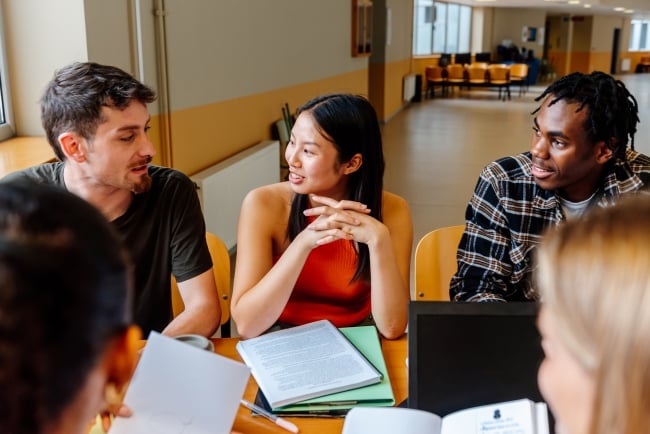You have /5 articles left.
Sign up for a free account or log in.

Since the pandemic, colleges and universities have seen students’ socio-emotional readiness decline. Helping students build interpersonal and executive functioning skills can contribute to succeeding.
Alberto Menedez/iStock/Getty Images Plus
During the COVID-19 pandemic, students in the K-12 system and at higher ed institutions fell behind in their academic preparation due to a lack of in-person learning. But remote learning impacted more than just students’ reading and writing skills; today’s college students are on a delayed trajectory of socio-emotional behavior development due to the pandemic, as well.
A new report from EAB and Seramount found, among college-readiness metrics, students are struggling to meet expectations in and outside the classroom, which could have effects on their lives beyond education.
The research, which connects a decline in student readiness from K-12 to early career employment, may be relieving to some higher education officials who think they’re the only ones encountering these challenges, says Carla Hickman, vice president of research at EAB. But the findings only reinforce higher education’s role to prepare students for their next steps, regardless of K-12 experiences.
Methodology
The paper’s insights draw on work from EAB and Seramount, a professional services research firm, with over 2,800 institutions, 150 partner interviews and data analysis.
State of play: Socio-emotional readiness and executive functioning have declined for years, but they further lagged among America’s youth due to limited in-person instruction during the pandemic, Hickman says.
Students didn’t engage in face-to-face play, sports, extracurriculars or other basic school routines or norms such as walking to class or expressing their needs in the classroom, according to the report.
Personnel at colleges and universities reported to EAB that they have noticed more students seeking mental health counseling and crisis services, struggling with resiliency, having difficulty with interpersonal communication and conflict resolution, and being less involved in student organizations or other social opportunities.
Social media has also played a role in hindering Gen Z’s emotional development, Hickman says, with students able to block or mute people who share differing opinions or share uncomfortable content, making them less equipped to handle conflict off-line. “You can’t live in the world that way.”
A lack of resilience and coping skills is also tied to the so-called student mental health crisis. Individuals with self-regulation skills are more likely to avoid mental health crises before they develop, and students who do have a diagnosed mental illness can better support themselves if they are socio-emotionally developed.
Even while enrolled, students say their experiences in higher education haven’t advanced their executive functioning skills. A 2023 study from the Mary Christie Institute found 39 percent of recent graduates believe college did not help them develop the skills needed to navigate the emotional challenges of transitioning to the workplace.
College readiness has downstream effects on students’ abilities to perform well in graduate education and in the workplace. Data collection found recent graduates struggle with professional writing and lack industry-specific technical skills, limiting their capabilities to grow and succeed.
So what? To increase student readiness within college and beyond, EAB’s report recommends the following actions:
- Name the skills for students. Faculty members can be explicit in calling out different skills that build socio-emotional readiness in their courses in the syllabus, such as creating moments for constructive dialogue, decision-making and giving and receiving feedback. This helps students understand where they may be lacking in certain areas.
- Upgrade orientation processes. Colleges and universities can reframe pre-term programming to an onboarding program that covers academic expectations as well as social and cultural norms in college. These programs should be sustained and repeated, not just a one-off event, according to the report. This can be one area to address the hidden curricula of higher education, particularly for first-generation students, Hickman says.
- Collect data early. One way to get ahead of students’ mental and emotional crisis is delivering onboarding surveys that screen learners for their concerns about the upcoming term, how they handle stress or how they rank their emotional help. This data can provide insight into who needs additional assistance and gauge overall student readiness.
- Get a pulse on students. In addition to institutional surveys, faculty members can incorporate pulse surveys during classes to identify students who may be struggling, such as before an important exam, Hickman says.
- Establish college success courses. As well as providing academic skills for success, these courses can also cover effective communication such as how to engage with faculty members, staff or peers.
- Build peer mentorship programs. Some students may be hesitant to ask for help from a staff member or authority figure, but a near-peer mentor can help guide students through challenges on campus, such as interpersonal disputes.
- Solicit feedback from employers. College leaders should engage local employers who provide internships, co-ops or job opportunities for students to receive relevant and specific feedback on where college preparation is lacking in equipping them for the workforce. Regardless of if employers say a college degree isn’t necessary for a role, “they’re still looking for skills that are best imparted in a college or university curriculum,” Hickman says.
Do you have a wellness tip that might help others encourage student success? Tell us about it.







